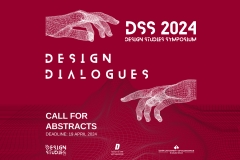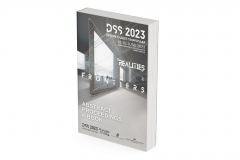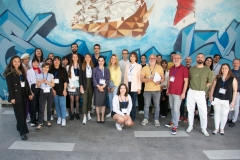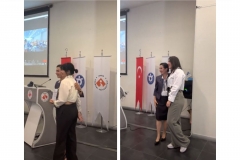
GRADUATE SCHOOL
Design Studies (With Thesis)
FFD 515 | Course Introduction and Application Information
| Course Name |
Discussions on Public Space: Design and Theory
|
|
Code
|
Semester
|
Theory
(hour/week) |
Application/Lab
(hour/week) |
Local Credits
|
ECTS
|
|
FFD 515
|
Fall/Spring
|
3
|
0
|
3
|
0
|
| Prerequisites |
None
|
|||||
| Course Language |
English
|
|||||
| Course Type |
Elective
|
|||||
| Course Level |
Second Cycle
|
|||||
| Mode of Delivery | - | |||||
| Teaching Methods and Techniques of the Course | DiscussionCase StudyQ&AField trip / ObservationLecture / Presentation | |||||
| Course Coordinator | ||||||
| Course Lecturer(s) | ||||||
| Assistant(s) | - | |||||
| Course Objectives | This course aims to focus on the discussions regarding contemporary issues and practices in the production, design and use of public space from the perspectives of different design disciplines. The course will also criticize the implications for future design and public policy. By the help of the discussion on several examples from an international and comparative perspective from İzmir, Turkey and the world, this course aims to discuss cultural, politic and contextual effects on the production of public spaces. |
| Learning Outcomes |
The students who succeeded in this course;
|
| Course Description | This course is structured on the readings and discussions regarding three main focuses on theories and experiences of public space, equity and access issues, and design and management of public spaces. |
|
|
Core Courses | |
| Major Area Courses | ||
| Supportive Courses | ||
| Media and Management Skills Courses | ||
| Transferable Skill Courses |
WEEKLY SUBJECTS AND RELATED PREPARATION STUDIES
| Week | Subjects | Related Preparation |
| 1 | Introduction to the course themes. Distribution of final presentation and seminar topics to each student. | |
| 2 | Theories and Experiences of Public Space: Why does public space matter? Public sphere vs the public realm. | Readings: Mitchell, Don (1995) “The End of Public Space? People's Park, Definitions of the Public and Democracy” Annals of the Association of American Geographers, Vol. 85, No. 1 pp.108-133. Schmidt, S. & Németh, J. (2012). Space, place and the city: Emerging research on public space design and planning. Journal of Urban Design, 15(4) , 453-457. Lofland, L. H. (1989). A social life in the public realm. Journal of Contemporary Ethnography, 17(4), 453-482. Assignment 1a: Bring a visual (i.e. a photograph, a video or some other non-textual representation from your own collection, from a book/magazine or from the web) of a public space. |
| 3 | Theories and Experiences of Public Space: Typology: parks, streets, plazas, “third spaces” and quasi-public places | Readings: Low, S., Taplin, D., & Scheld, S. (2005). Rethinking public parks: Public space and cultural diversity. Austin, TX: University of Texas Press. Ch. 2. Akış, T. (2011). İzmir'de yeşil alan kullanımı: Karşıyaka sahilinde gündelik hayat. TMMOB Mimarlar Odası Ankara Şubesi Dosya 27 , 63-70. Assignment 1b: Go to a public space, enjoy and bring a photo. |
| 4 | Theories and Experiences of Public Space: Historical overview | Readings: Banerjee, T. (2001). The future of public space: beyond invented streets and reinvented places. Journal of the American Planning Association, 67(1), 9-24. Uzun, İ. K., & Şenol, F. (2020). Recent" nation gardens" and historical development of public green spaces in Turkey. Art-Sanat Dergisi. Assignment 1c: Find old and existing images of a public space and bring them to the class. |
| 5 | Discussion paper presentations | Assignment1a,b,c Presentation: Based on the first three assignments, write a discussion paper. |
| 6 | Access, Social Justice and Use: Women and Public Space | Readings: McDowell, L. (1999). Gender, Identity and Place: Understanding Feminist Geographies. Minneapolis: Minnesota Press. Byrne, J. & Wolch, J. (2009). Nature, race, and parks: past research and future directions for geographic research. Progress in Human Geography, 33(6) , 743-765. Assignment 2a: Research and find an incident representing women’s experiences in public space. |
| 7 | Access, Social Justice and Use: Age and Public Space | Readings: Sideris, A. L. & Sideris, A. (2009). What brings children to the park? Analysis and measurement of the variables affecting children's use of parks. Journal of the American Planning Association, 76(1) , 89-107.Payne, L. L., Orsega-Smith, E., Roy, M., & Godbey, G. C. (2002). Local park use and personal health among older adults: An exploratory research. Journal of Park and Recreation Administration, 23(2) , 1-20.Assignment 2b: Research and find an incident representing children’s experiences in public space. |
| 8 | Access, Social Justice and Use: Environmental justice and inequity | Readings: Boone, C., Buckley, G., Grove, J., & Sister, C. (2009). Parks and people: An environmental justice inquiry in Baltimore, Maryland. Annals of the Association of American Geographers, 99(4), 767-787. Rigolon, A. (2016). A complex landscape of inequity in access to urban parks: A literature review. Landscape and Urban Planning, 153, 160-169. Assignment 2c: Research and find an incident highlighting access/exclusion/equity issues in public space |
| 9 | Discussion paper presentations | Assignment2a,b,c Presentation: Based on the first three assignments, write a discussion paper. |
| 10 | Outline Presentations of Final Papers | Assignment3 Presentation: Bring the outline of your final paper. |
| 11 | Design, Policy, Management and Observation: Design and Policy Making | Readings: Madanipour, A. (1999). Why are the Design and Development of Public Spaces Significant for Cities. Environment and Planning B, 26 , 879-891. Leorke, D. (2015).The Struggle to Reclaim the City: An Interview With Michael Sorkin. Space and Culture, Vol18(1); 98-105. |
| 12 | Design, Policy, Management and Observation: Design and Policy Making | Readings: Golicnik, B., & Thompson, C.W. (2009). Emerging relationships between design and use of urban park spaces. Landscape and Urban Planning, 94 , 38-53. Sister, C., Wolch, J., & Wilson, J. (2010). Got green? Addressing environmental justice in park provision. GeoJournal , 229–248. Carmona, M., Heath, T., Oc, T., & Tiesdell, S. (2010). Public places, urban spaces: the dimensions of urban design. New York, NY: Routledge. Ch. 7. |
| 13 | Design, Policy, Management and Observation: Privatization and Threats to Public Space | Hackworth, J. and Smith, N. (2001), The changing state of gentrification. Tijdschrift voor economische en sociale geografie, 92: 464-477. Sorkin, M. (1992). Variations on a Theme Park: The New American City and the End of Public Space. New York: Hill and Wang. |
| 14 | Final Paper Presentations | Prepare for presentation |
| 15 | Semester Overview | |
| 16 | Review of the Semester |
| Course Notes/Textbooks |
|
| Suggested Readings/Materials |
EVALUATION SYSTEM
| Semester Activities | Number | Weigthing |
| Participation |
1
|
10
|
| Laboratory / Application | ||
| Field Work | ||
| Quizzes / Studio Critiques | ||
| Portfolio | ||
| Homework / Assignments |
1
|
30
|
| Presentation / Jury | ||
| Project |
1
|
40
|
| Seminar / Workshop |
1
|
20
|
| Oral Exams | ||
| Midterm | ||
| Final Exam | ||
| Total |
| Weighting of Semester Activities on the Final Grade |
3
|
60
|
| Weighting of End-of-Semester Activities on the Final Grade |
1
|
40
|
| Total |
ECTS / WORKLOAD TABLE
| Semester Activities | Number | Duration (Hours) | Workload |
|---|---|---|---|
| Theoretical Course Hours (Including exam week: 16 x total hours) |
16
|
3
|
48
|
| Laboratory / Application Hours (Including exam week: '.16.' x total hours) |
16
|
0
|
|
| Study Hours Out of Class |
14
|
8
|
112
|
| Field Work |
0
|
||
| Quizzes / Studio Critiques |
0
|
||
| Portfolio |
0
|
||
| Homework / Assignments |
3
|
7
|
21
|
| Presentation / Jury |
0
|
||
| Project |
1
|
30
|
30
|
| Seminar / Workshop |
1
|
14
|
14
|
| Oral Exam |
0
|
||
| Midterms |
0
|
||
| Final Exam |
0
|
||
| Total |
225
|
COURSE LEARNING OUTCOMES AND PROGRAM QUALIFICATIONS RELATIONSHIP
|
#
|
Program Competencies/Outcomes |
* Contribution Level
|
||||
|
1
|
2
|
3
|
4
|
5
|
||
| 1 | to be able to expand the practical knowledge gained in undergraduate programs with theoretical field of design research, |
|||||
| 2 | to be able to examine, interpret data and assess concepts and ideas with research methods of design theory and social sciences, |
|||||
| 3 | to be able to identify problems of design disciplines in times of global / environmental crisis and to be able to develop possible solutions for design practitioners, |
|||||
| 4 | to be able to expand knowledge on the history of material culture as it relates to design practices of the past, |
|||||
| 5 | to be able to promote research on local practices of everyday life and assess the outcome to implement design solutions, |
|||||
| 6 | to be able to facilitate interactions in between varied design disciplines and to promote collaborative work to solve complex problems, |
|||||
| 7 | to be able to process outcome of design research to be applied in design education, |
|||||
| 8 | to be able to instigate research on the new tools, technologies and materials of production in order to accelerate changes in design practices, |
|||||
| 9 | to be able to develop an ethical approach towards design professions in order to install social and environmental responsibilities, |
|||||
| 10 | to be able to use a foreign language for both chasing the scientific publication and developing proper communication with colleagues from other countries, in written and verbal ways. |
|||||
| 11 | to be able to use computer programs needed in the field design as well as information and communication technologies in advanced levels (“European Computer Driving Licence”, Advanced Level”). |
|||||
*1 Lowest, 2 Low, 3 Average, 4 High, 5 Highest
NEWS |ALL NEWS

DSS 2024 CALL FOR PAPERS | THEME: DESIGN DIALOGUES
DSS 2024 CALL FOR PAPERS THEME: DESIGN DIALOGUES The Design Studies Graduate Program and the Faculty of Fine Arts and Design at the Izmir

Abstract Proceedings e-Book for the Design Studies Symposium 2023 is available now!
The Design Studies Symposium 2023 (DSS 2023), organized in collaboration with İzmir University of Economics Graduate School Design Studies Master's and PhD

Design Studies Symposium 2023: Realities & Frontiers
The Design Studies Symposium 2023 (DSS 2023) organized by the IEU Graduate School Design Studies programs was held on 1-2 June, at

The Best Paper Award at the Design Studies Symposium 2023: Realities & Frontiers
The voting for the best presentation award at the Design Studies Symposium 2023 (DSS 2023) organized by the IEU Graduate School Design




